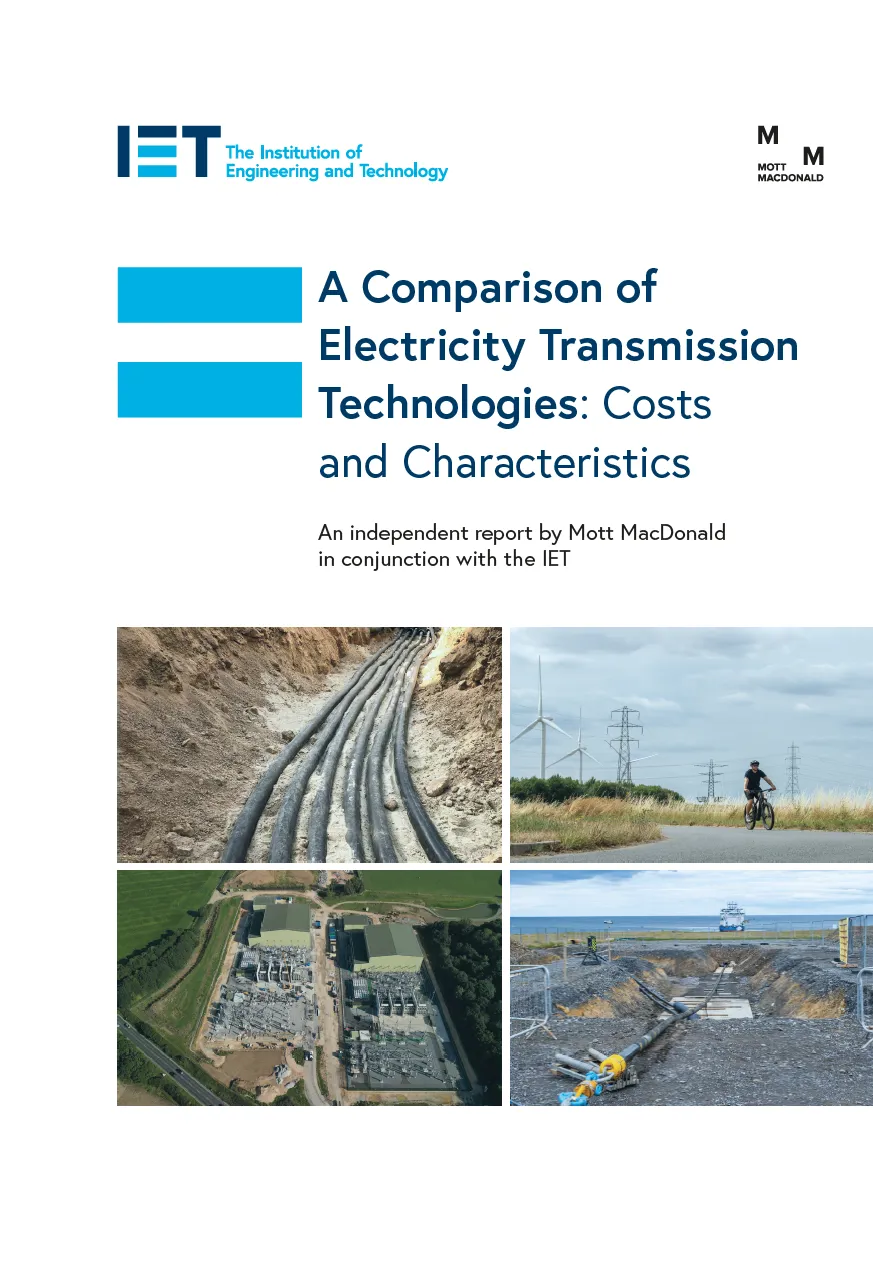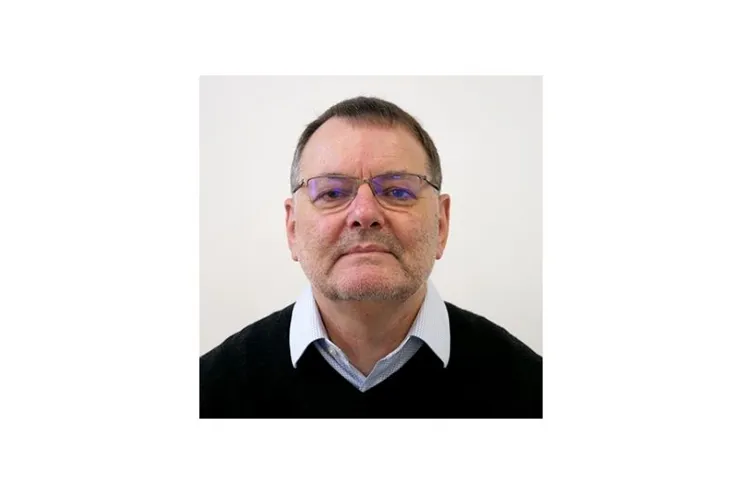Published: Tue 29 Apr 2025
A comparison of electricity transmission technologies: Costs and characteristics
An Independent Report by Mott MacDonald in conjunction with the IET.
As the UK embarks on its most ambitious grid upgrade since the 1960s, this comprehensive report sheds light on the various technologies available to re-wire Great Britain, ensuring a greener, more efficient, and secure energy future.
Report downloads
Key insights
- Cost Comparisons: Discover why underground cables are, on average, 4.5 times more expensive than overhead lines, and how offshore HVDC solutions can be up to 11 times more costly.
- Technological Merits: Understand the importance of evaluating each technology based on environmental impact, engineering challenges, and local considerations.
- Supply Chain Dynamics: Learn about the bottlenecks in cable manufacturing and the necessity for long-term partnerships with providers.
Why it matters
To harness Britain's wind energy resources and meet the growing demand for electricity, a significant expansion of the transmission network is essential.
This report provides detailed options for enhancing the existing network and adding new capacity, summarising the average lifetime cost of providing 1 MW of new network capacity over a distance of 1 km.
Beyond costs
Explore the non-cost factors that play a crucial role in grid development, such as visual and environmental impacts, sustainability, and engineering challenges.
From underground cables to subsea solutions, each technology offers unique advantages and considerations.
A collaborative effort
Coordinated and published independently by the IET, with research conducted by international engineering consultancy Mott MacDonald, this study updates previous data from 2012 and incorporates insights from a wide range of industry experts.

Hear from the experts

Professor Keith Bell
Chair of the Project Board for the IET Transmission Technologies report, said:
"As an essential part of the country's aim to reach net zero, the UK is decarbonising its production of electricity and electrifying the use of energy for heating, transport and industry.
"Access to a cleaner, more affordable, secure supply of energy requires the biggest programme of electricity transmission development in two generations."

Professor John Loughhead
Member of the report’s Project Board and IET Fellow and Past President said:
"This report provides a rich information resource on the technology choices for development of the electricity transmission network.
"It will help inform and stimulate essential discussions between policy makers, local authorities, local communities and bill payers as options are considered."

Professor Andrew Lovett
Member of the report’s Project Board and Professor of Geography at the University of East Anglia added:
"This situation is complex with no simple environmental choices. When deciding between underground cables, overhead lines or subsea cables off Britain's coast, we must consider a complex range of impacts unique to each project.
"Each technology needs to be evaluated based on its specific context, including engineering challenges, local impacts, and costs."

Katherine Jackson
Member of the report’s Project Board and an energy specialist said:
"The insightful relative lifetime costs are based on several assumptions and will be subject to global inflationary pressures.
"In practice, the costs and benefits of the different technologies depend very much on the specifics of individual projects, so there is no one-size-fits-all solution."

David Reid
Global Practice Leader, Integrated Electricity Networks, at Mott MacDonald, and lead author of the report, said:
"The country’s electricity infrastructure will play a vital part in achieving the UK’s net zero targets, but it needs to be significantly expanded and upgraded. This report provides valuable insight into the different technology options available and their relative merits.
"It will be a vital resource in supporting stakeholders with accelerating the necessary infrastructure development needed for UK society to achieve net zero."
FAQs
Why is the electricity network so important?
The electricity network is crucial for modern society, powering essential services in homes, businesses, hospitals and schools.
As the UK aims for net-zero emissions, this network is key to decarbonising the energy sector by integrating low carbon energy sources and supporting the electrification of heat and transport.
Current status
Britain's abundant wind resources and proven wind farm industry offer a lower-cost energy solution compared to new gas-fired generation alternatives.
Embracing low-carbon energy is crucial to reduce reliance on volatile fossil fuel markets, which can be affected by geopolitical instability, aligning with the urgent goals of the Clean Power 2030 Action Plan.
However, optimal wind farm locations often don't align with the existing electricity transmission network that was designed and built primarily in the 1960s. To harness affordable wind energy and keep electricity bills low, network development is essential.
How does the UK’s transmission network compare with those in other countries?
Every large electricity transmission network around the world uses mainly overhead lines on pylons, with some use of underground cables.
The UK is no different in this respect. It’s important to consider that every country is geographically different.
Although we can learn from other places and share in R&D and system planning, we cannot take a like for like template from another country.
Why do we need more capacity?
Transmission capacity is needed to:
- connect generation, energy storage and interconnectors to where there is demand for electricity
- transfer power between one region and another to facilitate the GB-wide wholesale electricity market and support security of supply.
To harness Britain's wind energy and meet rising electricity demand, a significant expansion of the transmission network is essential.
This will enable more effective use of low-carbon power, offering consumers cheaper, greener, and more secure electricity.
The high voltage transmission network is vital for accessing large-scale resources over long distances.
However, meeting government targets for network expansion is challenging, and delays in decarbonising the electricity system could hinder compliance with the 6th Carbon Budget and the 2030 and 2035 Nationally Determined Contributions towards Net Zero.
What are the costings from the report?
A useful representative metric for costs of electricity network capacity is the cost per MWkm: how much does it cost, on average, to transmit 1 MW of power over 1km.
In £/MWkm terms for lifetime costs, averaged over a range of distances and capacities for each technology option, the report finds the following:
- Underground cables buried in the ground are around 4 and a half times more expensive than overhead lines (OHL).
- An offshore high voltage direct current (HVDC) point-to-point cable connection is around five times more expensive than OHL.
- An offshore HVDC network connecting multiple sites to the onshore grid is around 11 times more expensive than OHL.
The actual cost ratio depends on the context and the relative impacts of fixed costs to connect new infrastructure into the existing network and the costs that vary with the length of a new or rebuilt route.
What does the lifetime cost comprise?
The overall lifetime cost of a technology option includes build cost plus, over the lifetime of the equipment, the cost of operation and maintenance, and the cost of energy lost due to transmission of power by that particular technology.
The cost of losses is highly sensitive to assumptions both for average loading of the equipment and how much it costs to replace the lost energy.
Aside from cost, what are the main findings regarding different transmission technology options?
The technologies explored have both positives and negatives; environmental and cost considerations play a significant role.
For example, underground cables have lower visual impact than overhead lines and less above ground ecological impact after construction, but they have adverse impacts on soils and much higher cost. Cables are not viable on steep inclines or rocky terrain.
Both overhead lines and underground cables place restrictions on use of land after construction.
Long high voltage cables carrying alternating current (AC) also present significant electrical engineering difficulties.
Development of transmission capacity using subsea cables off Britain’s coast might reduce the need for either onshore overhead lines or underground cables but it, too, would have higher cost; subsea cables also have environmental impacts.
Offshore transmission would not eliminate the need for onshore capacity which will still be needed to allow power to reach electricity users.
On what basis are decisions made between different transmission technology options?
If transmission capacity already exists between two locations but needs to be increased, it is first assessed whether:
- existing infrastructure can be better utilised to facilitate the required transfers of electrical power, e.g. through installation of power control devices, operation of electrical conductors at higher temperatures or replacement of conductors on existing towers
- new lines are required.
If new lines are required, an assessment is made of which technologies would be feasible between the required locations, e.g. overhead lines, underground cables, and subsea cables.
There would also be an assessment of whether AC or DC should be used.
A decision on the preferred option is made based on answers to questions that include the following.
- What is the most cost-effective option for delivering the required power transfer capacity?
- How quickly can it be delivered?
- What impacts will it have on the local environment?
- How can adverse environmental impacts be reduced? Is it possible to bring about positive impacts, such as for biodiversity?
- What are the technology or supply chain risks?
- How flexibly can the option be operated?
- How easily can the option be adapted to changing system needs?
- What energy losses will operation of the option incur?
- How much CO2 will be emitted in manufacture and construction of the option?
What is HVDC?
High Voltage Direct Current (HVDC) is a newer technology used to transmit electrical power over long distances using direct current (DC) instead of the more common alternating current (AC).
What are the key differences between underground or subsea cables and overhead lines?
An electrical connection between two locations requires adequate electrical insulation to prevent short circuits, i.e. current going where it shouldn’t.
Overhead lines comprise bare electrical conductors (typically made of aluminium) suspended in the air, usually supported by steel lattice towers or, at lower voltages, wooden poles.
The electrical insulation is provided by specialist materials on the connection to towers or poles and, otherwise, by large air gaps between the conductors of each ‘phase’, and between the conductors and the ground or objects such as vegetation, buildings or road vehicles.
Underground and subsea cables insulate the conductors – either copper or aluminium – from other phases and their surroundings using specialist materials surrounding the conductor.
There would also be protection from water ingress and there might be ‘armouring’ to provide extra mechanical strength and protection from damage.
How many ‘wires’ are there on a transmission line and what is a ‘phase’?
Power systems around the world, including in Britain, conventionally use alternating current (AC) and three ‘phases’.
Each connection between two locations on the network constitutes a ‘circuit’ and each circuit comprises three ‘wires’, i.e. bundles of electrical conductor that carry current, one for each phase.
Current flows from a higher voltage to a lower voltage. Voltages on the three phases are different from each other and vary continuously in time.
There will always be voltage differences between the phases determining how the ‘wires’ associated with each phase share the outward and return currents once a connection is made, at the far end of the network through a generator, energy storage, device or electrical appliance.
For example, at one moment, one phase will be carrying the outward current and the other two share the return.
Towers used for overhead transmission lines in Britain typically carry two circuits: the three phases for one circuit are on side of the tower and the three phases for the other circuit on the other side. Towers also carry ‘earth’ wires that provide a common reference point for zero volts.
AC underground cable connections also comprise three phases with a minimum of one cable for each phase, each of which must be electrically isolated from the other phases to prevent short circuits between them.
(A closed circuit should only be made via equipment designed to be connected to the network, such as generators, energy storage devices or electrical appliances. These should only be connected at appropriate voltages.
One of the key features of an AC system is the ability to step up and down between different voltage levels, ensuring that appliances can be safely connected at voltages for which they’re designed).
In a direct current (DC) system, there are two ‘wires’ for each circuit. Typically, these are one for the positive ‘pole’ (that has a voltage above zero) and the other for a negative ‘pole’ (that has a voltage below zero).
These provide outward and return paths for current. There might also be an earth wire. As with an AC system, this provides a common reference for zero volts and helps with safety.
The conductors used on transmission networks are typically made of aluminium or copper, materials that have low electrical resistance. Whenever current flows, the conductors heat up. How much aluminium or copper is required in a conductor bundle, or ‘wire’, depends on how much current it is intended to carry.
The key factor determining maximum current is how hot the conductor bundle can be safely allowed to become. Hence, each transmission circuit – whether AC or DC, overhead, underground or subsea – has a ‘thermal capacity’ or ‘thermal limit’ determining the maximum power it can carry.
What are some of the main transmission network delivery challenges found by the report’s authors?
The report highlights significant supply chain issues, particularly in cable manufacturing, causing delivery delays and necessitating long-term partnerships with suppliers. Global inflation is pressuring manufacturers, who struggle to meet delivery schedules due to full order books.
Consequently, cost data can quickly become outdated, and newer technologies face uncertainties in cost and performance. This report uses costs as they were when key data were gathered in late 2022 and 2023.
Supply chain pressures are continuing to increase costs for infrastructure such as converter stations and offshore platforms. This must be considered when making projections for future projects.
HVDC vs HVAC
High Voltage AC (HVAC) systems have lower initial costs as they don't require expensive converter stations to convert between AC and DC. AC is the standard for generation, transmission and distribution, seamlessly integrating into the existing 50 Hz power grid without special conversion.
AC is needed to transform voltages between high and low levels: high voltages for long distance, high power transfers with lower energy losses than at lower voltages; low voltages for more local distribution with easier electrical insulation.
AC lines can easily serve multiple load centres and substations, unlike HVDC which requires an expensive converter station for each connection into the existing grid or for connection to each power station or large demand centre.
Additionally, engineers, utilities and regulators are more familiar with AC, making maintenance, training and operations well-established.
While AC is ideal for ‘meshed’, multi-terminal networks, ongoing research could make HVDC more viable for ‘multi-terminal’ networks in the future. Between Caithness, Moray and the Shetland Isles, the UK has implemented Europe’s first HVDC multi-terminal HVDC system – in this case, 3 terminals – using the most modern form of converter station (a ‘voltage source converter’).
Can HVDC be used over shorter distances?
Where subsea or underground cables need to be used, such as for connecting offshore wind farms, HVDC avoids the electrical complications of AC subsea or underground cables. The report notes that very long AC underground cable sections may not be technically feasible.
However, HVDC is not economically viable for short connection lengths due to the high cost of converter stations and complex maintenance needs, making traditional HVAC systems more economical.
One of the main uses of HVDC internationally is for very long circuits in large countries or between countries. It is unlikely that building such long routes entirely over land would make sense in planning the GB energy system.
The report covers the use of ‘embedded’ HVDC – making a connection between two parts of the same AC network – using subsea cables at distances between 90km and 275km. For a link with a 2000 MW capacity, the pair of converter stations has been found by the report’s authors to cost £684 million, irrespective of the length of the connection.
This represents 83% of total build cost for a 90km connection, and 62% for a 275km connection. The connection must be longer than around 550km before the converter stations are less than half the build cost.
Where underground cables are considered with HVDC, using data provided in the report, the lifetime costs of 100 km and 200km HVDC ‘embedded’ links with capacities of 2000 MW can be estimated to be £8,630/MWkm and £4,900/MWkm respectively.
For comparison, the average 400 kV overhead line lifetime cost in the report is £1,190/MWkm. However, the report also notes that “the cost certainty for the HVDC solution is somewhat less than that of the a.c. solutions”.
Can T-pylons be used instead of steel lattice towers?
T-pylons can only be used in certain terrains as there is a need for much larger foundations. The total amount of steel used is also much larger and the cost is higher.
The lifetime costs are around 1.6 to 1.7 times those of a conventional overhead line, for example 15km at 4,988 MW = £129.54m; 75km at 4,988 MW = £647.68m.
What is cable ploughing and does the report cover it?
A cable plough is a tool that allows cables to be laid underground efficiently without extensive trench works. It
carves through the soil at the desired depth, lays the cable, and then covers it with the native soil, enabling continuous laying of each section of cable. This method offers advantages such as faster installation, minimal environmental disruption and fewer preparatory works.
However, there are limitations. The authors of the report are unaware of a suitable machine for 400 kV use, although a cable ploughing company, ATP, is understood to have demonstrated a small-scale installation in South Wales.
The plough can navigate obstacles with a bending radius of 4 meters but is likely to be inappropriate for hard soil or rock. For transmission circuits requiring backfill with specific thermal characteristics, a cable plough is judged likely to be unsuitable.
Cable ploughing was not in the scope of the report – it is only currently operational at 132 kV, and this report looks at high voltage electricity transmission systems.
The report’s authors found no examples anywhere in the world of cable ploughing having been used at 275 kV or above. Further work is needed to check its feasibility and ascertain its cost.
Are there any health reasons for/against pylons or underground cabling?
The report does not look at any potential health issues that stakeholders might associate with any of the technologies.
All electrical equipment, such as overhead lines, cables and substations, must comply with UK Health Security Agency’s recommended exposure guidelines.
How will this affect bills and house prices?
The report does not look at the impact on bills or house prices – it has looked solely at the costs of the different technologies.
What are the next steps?
Development of Britain’s electricity transmission network is a complex challenge and requires solutions tailored to local conditions based on future power needs and the capacity of the existing network.
Each technology should be evaluated on its specific merits, considering engineering challenges, local impacts, and costs.
An informed debate is necessary to determine the best options, relying on trusted institutions and leaders.
Decisions must consider national emissions reduction priorities, local environmental and social impacts, engineering feasibility, deliverability, reliability, energy users' willingness to pay for electricity, and the cost of the network to access it.
